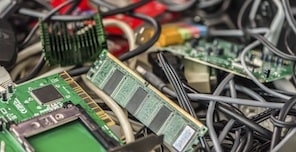Artificial Paper Skin Sensors
A low-cost paper-based multisensory platform that mimics the sensations of human skin
Technology summary
Paper is a universally widespread material that is available in every household due to its low-cost. Using paper as a substrate and sensing material for sensors fabrication can be advantageous due to its porosity and larger interfacial area. These characteristics contribute to high sensitivity and faster response times.
KAUST electrical engineering scientists have developed a flexible and non-functionalized low-cost multi-sensory platform fabricated from common paper and other off-the-shelf materials such as sponges and aluminum foil.
This technology presents a cheaper alternative to the widespread artificial skin systems and increased functionality through real-time and simultaneous detection of various stimuli, including touch, pressure, flow, proximity, temperature, acidity and humidity.
How it works
Paper skin is developed through the 3D integration of pressure, temperature and humidity sensor arrays. This stacking configuration enables simultaneous and localized detection of various external stimuli per pixel. Sensor arrays are developed through simple resistive and capacitive designs made from electrically insulating and conductive materials that are incorporated onto a Post-it note.
Post-it notes are used as the hosting substrate and sensing materials for the humidity sensors. The porous nature of cellulose paper enables fast absorption and evaporation of water on its surface, enabling the detection of relative humidity levels with faster response and recovery times. Temperature detection is achieved through a resistive aluminum foil structure, changing its resistance with temperature variations. Pressure sensing is possible through the porosity and compressibility of the sponge, where aluminum foil serves as the conducting electrode of the parallel-plate capacitor structure. The design and material choice of this pressure sensor enables the unique recognition of touch, flow speed and direction and proximity with a 13 cm detection range.
Why it is better
It is the only low cost, recyclable and accessible multisensory platform that integrates most sensory functionalities associated with human skin.
The process is modest and simple, yet this technology performs the same, if not better, than widely used and expensive artificial skins currently on the market.
This technology is targeted at making healthcare monitoring systems accessible and affordable for the people who need it the most – often the people who do not have access to niche and expensive technologies.
IP protection
Patents pending
Invention track code
2015-102

Advantages
- Wearable and flexible
- Extremely low-cost and accessible
- Recyclable
- Scalable
- Multi-sensory platform beyond human skin sensations
- Real-time and simultaneous sensing capability

Applications
- Mapping of environmental conditions
- Wearable health monitoring systems (e.g. heart rate and blood pressure)
- Monitoring employees working in hazardous environments
- Artificial skin in robotics for increased perception of the surroundings
- Touch-free human-machine interfaces

